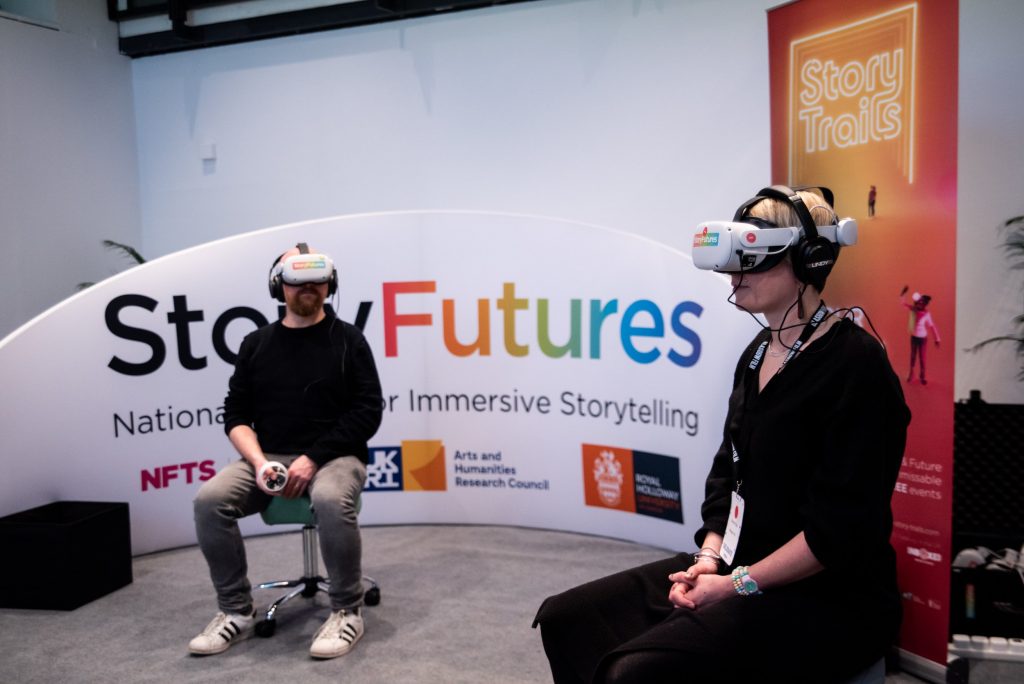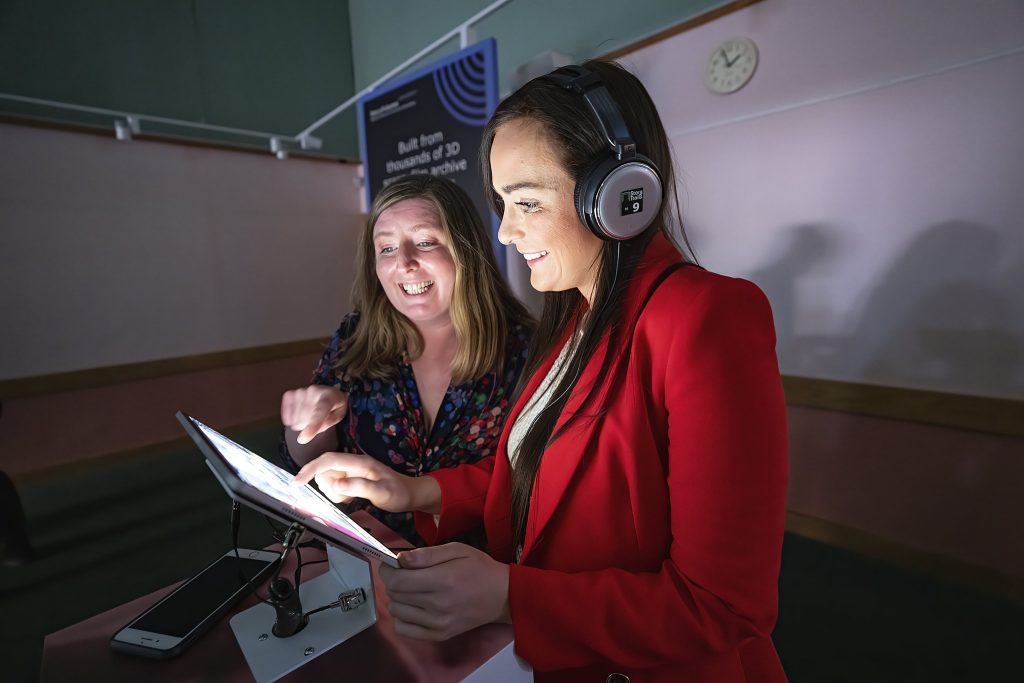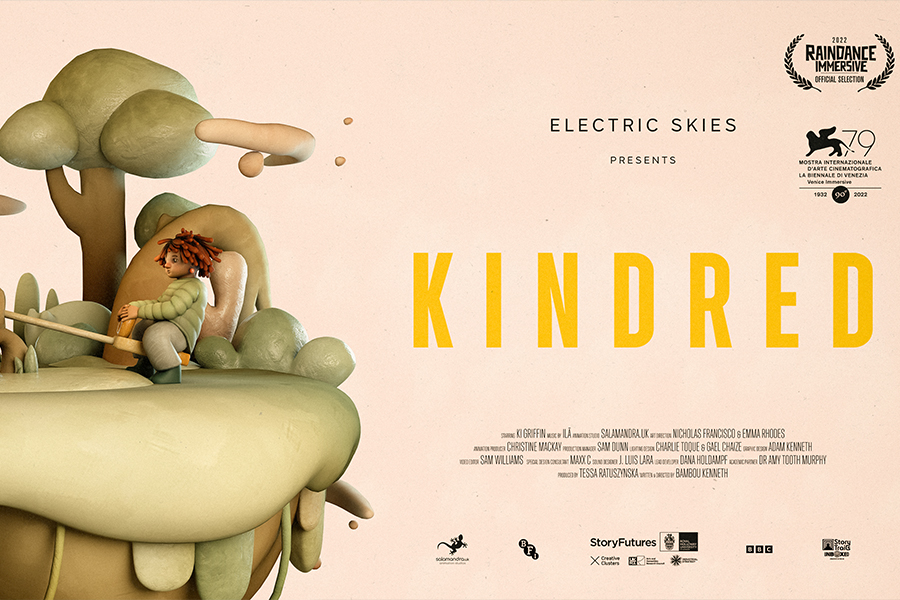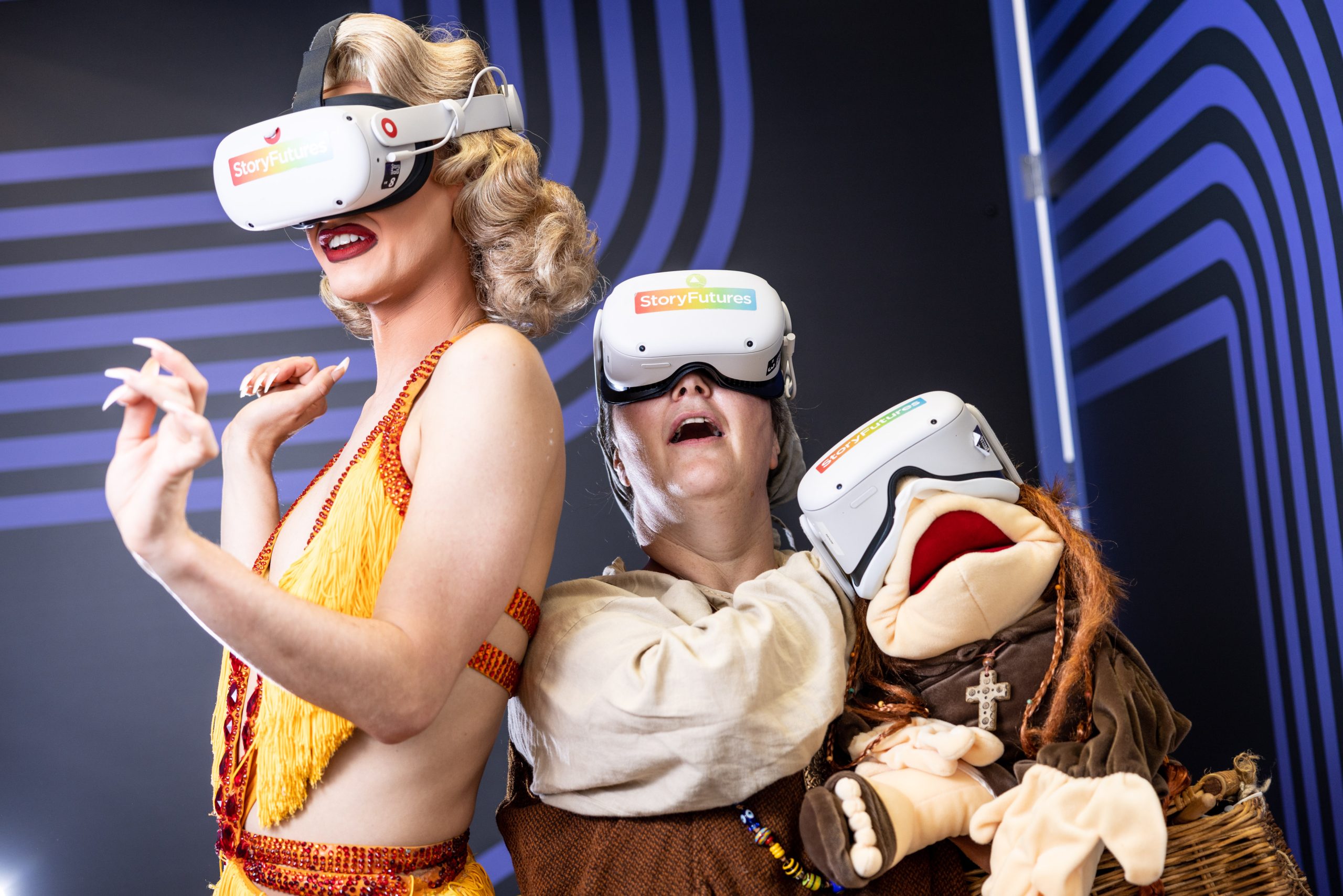QUESTION: How do you build a People’s Metaverse?
ANSWER: One library at a time…
We’re living in an incredibly exciting time to be making experiences. New technologies like AR, VR and the rapidly developing metaverse are giving us new tools to express our vision and connect with people.
However, right now the barrier for engagement with these technologies is often too high for the average person to take part. Tech investors and crypto bros might be excited about the potential of the metaverse – but how do we ensure that as we enter the next chapter and it become a more pervasive influence in our everyday lives, all corners of society are equally represented and included?
Will Saunders, the CCO of StoryFutures – an R&D hub in the UK funded by UK Research & Innovation to deliver innovation around storytelling – recently completed a radical project to address exactly this question.
In 2022 over 1.5 million people encountered StoryTrails, a collaboration between StoryFutures and the BFI, BBC, Niantic and other leading UK companies in the immersive space.
StoryTrails allowed people to experience their hometown in a completely new way through the magic of augmented and virtual reality. Audiences time-travelled via the wonder of these new immersive technologies to experience untold local stories in the heart of their communities.
Libraries up and down the UK were turned into virtual portals through which to explore stories of historical change and our compelling connections to place and to one another.
The project had 50 new creatives at the helm, generated over 7,000 scans, 400 different stories, and 13 hours of original content to become the UK’s largest immersive storytelling project to date – as well as a rich source of learnings for experience creators looking to use innovative technologies impactfully and responsibly.
Saunders shares the highs, lows and near-misses and asks: what on Earth were they thinking…?!
A New Form Of Storytelling For The 3D Internet

Saunders’ background isn’t in technology or emerging media, but in storytelling. Having started out as a comedy producer and music broadcaster, he was lured towards working in internet media as it offered lots of unknown potential to tell stories in a different way for the first time.
Today, the metaverse and digital technologies like AR and VR offer the same possibilities. StoryFutures looks to unlock these possibilities by exploring innovation in story form across the UK’s creative industries. Its ROI is to grow the UK’s immersive and creative economy, not to make a commercial return.
“Funded R&D is one of the most interesting ways you can journey into the unknown. Otherwise it’s hard to get money for things people don’t understand or don’t know are going to work!”
Will Saunders
StoryFutures works with companies including Punchdrunk, Nianic, the BBC, Sky and the RSC to understand what they’re capable of as storytellers. Its programmes include experimental labs, co-productions, professional placements, training and large-scale innovative programmes – for example, the first AR experience for children produced with The National Gallery, or the immersive VR piece Kindred at Venice Film Festival.
StoryTrails is the biggest project that StoryFutures has done to date. Its mandate was to deliver a new form of storytelling to the public.
“Most of what we do is with the existing creative industries, but the magic of the 3D internet is largely unknown. We wanted to share that and make it visceral for the public.”
Will Saunders
When the 3D internet is available and understood, it will become as important as the 2D internet – but no-one is publicly making the case that it should be freely available to everybody. The ultimate aim of StoryTrails was to make the case for this “people’s metaverse”.
The Case For Inclusive Innovation In A Commercial World

Most people in the UK stay close to the area and the people they grew up in. But post-Covid, many people had experienced a sense of isolation from their communities. One of the chief aims of StoryTrails was therefore to reconnect people to their local landscape and reflect the full diversity of the UK.
“And of course, we also wanted to make people laugh, cry, or learn something about themselves!”
Will Saunders
The project’s lead patron was the historian and broadcaster David Olusoga, who has previously attacked the UK creative industries for not being diverse or inclusive enough. Olusoga joined the project on the basis that it would put D&I at its heart and commit to hiring 50 creative practitioners who would get immersive training and be credited for their work.
Through reaching out to diverse groups on social media and in real life, the StoryTrails team created a cohort of creatives that spanned gender, race, disability and class. This also gave them the legitimacy to tell the stories of certain communities, as they came from or had a strong relationship with these places – for example, a poet from Omagh could address the bombings in the city in a way that others couldn’t, or shouldn’t.
“Sometimes we forget that where we live or grew up is a reason for people not to be given an opportunity. Projects like this encourage people to create content from the place they want to live, not where the industry tells them they should live.”
Will Saunders

StoryTrails was a touring programme around the UK delivering into 15 different libraries. All the stories showcased were tailored to a particular town to connect people to the place they came from. The programme consisted of a series of experiences that people would engage with, but didn’t always require a screen.
A people’s map of the UK was made by combining 3D scans with audio, creating new spatial maps that were played out as films on giant cinema screens or as immersive iPad experiences. The scans told the stories of people connected to each town who wouldn’t normally be put at the centre of this kind of project, and who hadn’t necessarily “achieved” anything: for example, one woman in Sheffield talked about how nightclub toilets were her favourite place!
People had powerful reactions to seeing their own stories played out in this way, with the universal reaction being one of joy at seeing something hyper local.
“It changed people’s perceptions of what is remarkable or worth celebrating: that small things are enough to put you on a map, and that a well-told story about something you care deeply about is valuable.”
Will Saunders
Other StoryTrails experiences included:
- Big Me Little Me: people were scanned to have a 3D avatar of themselves created. They could then take a photo with their giant or tiny self and share it. This proved particularly popular with families, and helped people understand how metaverse participation will depend on rapidly available technologies such as these.
- AR StoryTrails: created with Niantic’s developer kit and Nexus Studios, as well as resources from the BBC and BFI archives, these were wholly interactive experiences where people hired kit from the library for free and navigated a story through the city, unlocking audio and archive clips along the way. You could do this alone, but people enjoyed it even more as a communal experience when actors accompanied the tour, bringing the synergy of physical and digital to life.
- VR short-form documentaries: part of the project’s R&D investment went towards giving companies in the regions a remit to develop 6 VR stories, which were then screened in the libraries. These were always oversubscribed, and especially popular with children.
The project culminated in a BBC2 film made by David Olusoga, The People’s Piazza, on why place matters, made using virtual production techniques.
Lessons For The Future Of Immersive Storytelling

StoryTrails toured to an audience of 87,763, which grew to close to 1.5m across both physical and digital impressions. The team were able to gather data through 197 StoryBooth video-mediated interviews, 96 mini-interviews, 728 detailed surveys, and 535 paper surveys, which were analysed by a team of university researchers and ethnographers.
Some of the key lessons they learned were:
- Immersive experiences and the spatial internet are still new to most people, but can be magical when they experience them for the first time. 38% of the people that the project reached were new to immersive experiences, but 85% of them rated the AR experience four stars or higher, rising to 89% for the VR experiences. They may not have known a lot about the technology, but when they had it in their hands, they really liked it.
- Select the stories that suit these new technologies. We normally think in terms of story first, but some things work using these new formats, and others don’t. For example, VR might be brilliant for documentary storytelling, as it demands your full attention. However AR is better suited to gamified “treasure hunts” through an app. How might we work out which ones to use to make our story coherent – or which ones to take away? Saunders believes that in the future, immersive and augmented performances will have their own venues that suit the storytelling rather than using pre-existing ones – think Abba Beyond for example. The room and venue will become the screen.
- Public spaces such as libraries can help mitigate virtual exclusion. They are traditionally hubs where people can hang out and just be without buying something, but many are facing cuts and suffering. 71% of those who experienced StoryTrails said they would be more likely to return to libraries. 60% reported it made them proud of their city, and 89% optimistic about it.
- Teaching people to use technologies is easier than teaching them to tell stories. Storytelling is one of the hardest things to teach!
Saunders and the StoryTrails team are keen to see how the same concept might work internationally – the underlying experience and the way it was created could stay the same, but the content would change fundamentally.
The WXO Take-Out

There’s a huge opportunity to make the metaverse feel real for people as we move from 2D to 3D internet.
“How can we use what’s out there now that doesn’t involve big Hollywood budgets or devices? What can we do ourselves, and which helps learning?
Melanie Goodwin
We are 3D beings, but for thousands of years our learning has been 2D. For those who aren’t linear book learners, being able to move around what they’re learning both physically and chronologically will allow them to absorb information in a new way.
How many dimensions can we now put over a physically confined space?”
This multidimensional internet is particularly good for placemaking and community, as it means that the creator no longer has to have the dominant story. Instead these smaller stories can be co-created and use existing communal spaces, like libraries, as their canvas, allowing for enrichment whenever and wherever.
As we figure out the grammar of experience products, it’s also useful to think about where we’ve come from and the storytelling structures we’ve used in the past, and where we’re going. How might these structures survive? What will be different? And how can we create stories and experiences that will work not just now, but in the soon-to-be-here future?
So next time you’re creating an experience, ask yourself:
- What does inclusive innovation look like to you?
- How do we make the 3D internet freely available to all?
- Which formats do you use now? Which might you use in the future?
To see the full line-up for the WXO Campfires Season 6, click here.
To apply to join the WXO and attend future Campfires, click here.





